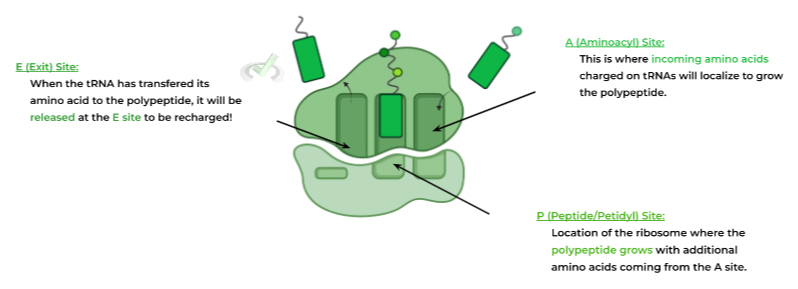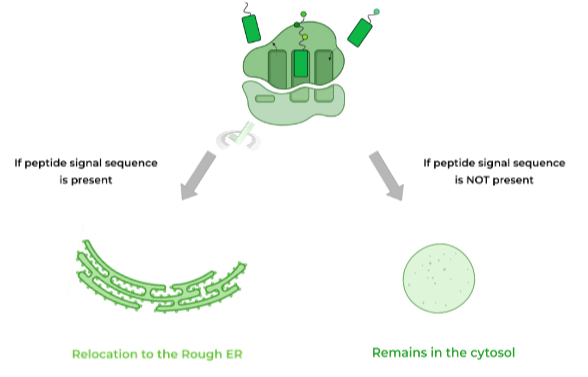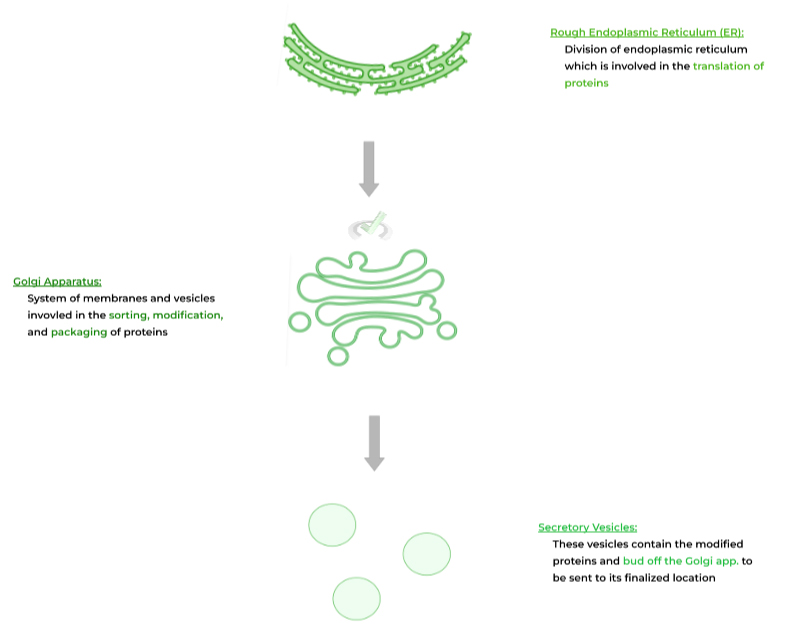I. What are the Fundamentals and Key Terms of Translation?
First off, we want to give you all a big congrats and pat on the back for reaching the final point of the central dogma articles! You’ve encountered what it takes to go from DNA to RNA: now, we just need to wrap up and see how we get to a protein.
Just like both the DNA replication and the RNA transcription articles, we’ll break this topic into 2 main articles: one dealing with various key terms and fundamental concepts and the other dealing with the processes involved in translation.
One way we like to think of translation is almost as the bridge between the micro and macroscale, referring to going from something much smaller in the form of DNA and RNA to something much larger and more directly involved in cellular processes, that being a protein.
II. Foundations of Translation
Let’s first talk about ribosome structure as a basis for understanding how translation works, as these will govern the step by step process of translation.
A. Ribosomal Structure: Role of ribosomal RNA (rRNA)
Recall that there are other types of RNA molecules besides mRNA: ribosomes are actually composed of rRNA (ribosomal RNA), which is synthesized in the nucleolus.
Ribosomes are composed of 2 subunits: 1 large and 1 small. The type of subunits used are actually different between prokaryotes and eukaryotes: eukaryotes use 60s/40s subunits while prokaryotes use 50s/30s subunits.

During translation, there are 3 sites within the ribosome that are involved in this process: 1) A site, 2) P site, and 3) E site. We’ll cover these sites more in the “Translation: Processes” article, but we’ll outline the basic concepts below:

B. Codon v.s. Anticodon: Role of Transfer RNA (tRNA)
As mentioned above, there are other specialized functions of RNA besides mRNA. In addition to rRNA as mentioned above, transfer RNA (tRNA) is another specialized RNA molecule important in translation. Like rRNA, tRNA also has a secondary RNA structure, specifically a hairpin loop!
Its main function is to bring in the appropriate amino acid that mRNA codons code for to the A site in order to grow the polypeptide chain! The tRNA is termed “charged” when the amino acid is attached to the RNA.

To ensure that the proper amino acid that a codon codes for is being delivered, the tRNA also contains an anticodon, which will have the complementary base pairs to the codon. If all is complementary, the amino acid will be added to the polypeptide chain!
Notice how the anticodon also runs antiparallel to the codon similar to DNA strands! Also recall that the 3rd nucleotide is the wobble codon which doesn’t match Watson-Crick base pairing, but still protects against mutations!
C. Differences in Translation Location
Translation will first occur in the ribosomes located in the cytosol; however, depending on the protein, translation can either 1) continue in the cytosol or 2) relocate to the rough endoplasmic reticulum (ER).
The main indicator of whether a protein will either continue translation in the cytosol or relocate to the rough ER is through a N-terminal signal sequence on the growing polypeptide.
III. Bridge/Overlap
Why would some proteins want to be translated in the rough endoplasmic reticulum and others remain in the cytosol? This all depends on the function and the final location of the protein. Let’s see how this works!
I. The Secretory Pathway
Some proteins are destined to be inserted into the plasma membrane or even secreted by the cell; in this case, the protein will be translated in the rough ER and enter into the secretory pathway, which is comprised of the endomembrane system as shown below:

Though drawn as arrows, it’s best to think of the endomembrane system as one continuous complex with organized interactions with one another. The secretory pathway is crucial in the proper functioning of a cell via protein delivery.
Whether it’s a receptor that needs to be embedded on the plasma membrane or interferons that need to prep other cells for viral infection defense, all of these originate with the endomembrane secretory pathway!
IV. Wrap Up/Key Terms
Let’s take this time to wrap up & concisely summarize what we covered above in the article!
A. Ribosomal Structure: Role of ribosomal RNA (rRNA)
Ribosomes are composed of specialized ribosomal RNA (rRNA) which is synthesized in the nucleolus. The ribosome is also composed of one large subunit (60s) and a small subunit (40s) in eukaryotes!
Within the ribosomes are also 3 different sites that are important for translation, which include the 1) A site, 2) P site, and 3) E site.
The A (Aminoacyl) site serves as an entry point for incoming charged tRNAs while the P (Peptide/Petidyl) site is where elongation of the polypeptide chain occurs. The E (Exit) Site is the point where empty tRNAs can exit ribosome to be recharged with another amino acid
B. Codon v.s. Anticodon: Role of Transfer RNA (tRNA)
Another specialized type of RNA with secondary structure which is responsible for bringing the appropriate amino acid to the ribosome to then be attached to the growing polypeptide chain.
Within the tRNA is an anticodon, the complementary triplet nucleotide sequence which will match with the codon of the mRNA. If the anticodon has the complementary match to the mRNA codon, the appropriate amino acid will be added to the polypeptide chain.
C. Differences in Translation Location
While translation begins with ribosomes in the cytosol, translation can either 1) continue in the cytosol or 2) relocate to the rough ER, depending on the presence of the N-terminal peptide signal sequence.
If this sequence is present, then translation will relocate to the rough ER and continue there. If no present, translation will continue in the cytosol.
Proteins will have to relocate to the rough ER if destined for the secretory pathway. These proteins usually have to be embedded in the plasma membrane or will be secreted by the cell.
V. Practice
Take a look at these practice questions to see and solidify your understanding!
Sample Practice Question 1
Suppose researchers are trying to specifically impede the translation of ONLY prokaryotes. Which of the following would be the best strategy to specifically target prokaryotic translation?
A. Inhibiting the synthesis of rRNA in the nucleolus
B. Creating an inhibitor for the 30s subunit
C. Decreasing the production of tRNAs
D. Lowering the amount of available amino acids
Ans. B
The key idea to this question is that we ONLY want to target prokaryotes, without affecting eukaryotic translation as well. Inhibiting the 30s subunit is catered specifically towards inhibiting prokaryotic translation.
All the other answers are all features that prokaryotic and eukaryotic translation share, not specifically singling out prokaryotic translation.
Sample Practice Question 2
Vasopressin/Antidiuretic Hormone (ADH) is a peptide hormone that’s released by posterior pituitary cells into the bloodstream in order to increase blood volume and pressure. Where does translation of the hormone primarily take place, the rough ER or cytosol?
Ans. Rough ER
Because ADH will have to be secreted into the bloodstream, it must enter into the secretory pathway and must be primarily translated in the rough ER.







 To help you achieve your goal MCAT score, we take turns hosting these
To help you achieve your goal MCAT score, we take turns hosting these 





















 reviews on TrustPilot
reviews on TrustPilot